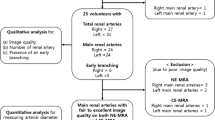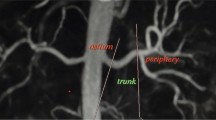Abstract
Objectives
Investigate the feasibility and evaluate the accuracy of non-contrast-enhanced MR angiography (NC-MRA) using time-spin labelling inversion pulse (time-SLIP)to identify crossing renal vessels (CRVs) in children requiring surgical treatment of ureteropelvic junction (UPJ) obstructionand compare to laparoscopic findings.
Materials and methods
Nineteen children ranging from 6 to 16 years of age underwent NC-MRA using the time-SLIP technique before surgery. Two independent readers analysed the MRA images. Number of renal arteries and presence or absence of CRVs were identified and compared with surgicalfindings. Image quality was assessed, as well as the presence of CRVs and measurement of renal pelvis diameter. Intra and inter-reader agreement was calculated using Cohen’s kappa coefficient and Bland–Altman plots.
Results
The overall image quality was fair or good in 88% of cases. NC-MRA demonstrated CRVs at the level of the obstruction in 10 children and no CRV in 9 children. All were confirmed intra-operatively except in one of the nine children. Sensitivity, specificity, NPV, PPV for predicting CRVs were 92%, 100%, 100% and 87.5%, respectively, for both readers.
Conclusion
NC-MRA is a good alternative to contrast-enhanced MRA and CT scanning for identifying CRVs in children with symptomatic UPJ.
Key points
• Time-SLIP technique offers acceptable imaging quality for identifying crossing renal vessel.
• Time-SLIP technique is easy to apply to the renal MRA examination.
• Time-SLIP technique is an alternative to contrast-enhanced MRA and CT scanning.





Similar content being viewed by others
Abbreviations
- CE-MRA:
-
Contrast-enhanced magnetic resonance angiography
- NC-MRA:
-
Non contrast-enhanced magnetic resonance angiography
- Time-SLIP:
-
Time spin labelling inversion pulse
- CRV:
-
Crossing renal vessel
- UPJ:
-
Uretero pelvic junction
- CDS:
-
Colour Doppler sonography
- bSSFP:
-
Balanced steady state free procession
- MAG3:
-
Mercaptoacetyltriglycine
- FSE:
-
Fast spin echo
- TSE:
-
Turbo spin echo
- BBTI:
-
Black blood inversion time
- MIP:
-
Maximum intensity projection
- ICC:
-
Intra-class correlation coefficient
References
Coley BD (2013) Caffey’s Pediatric Diagnostic Imaging. Elsevier Health Sci
Hoffer FA, Lebowitz RL (1985) Intermittent hydronephrosis: a unique feature of ureteropelvic junction obstruction caused by a crossing renal vessel. Radiology 156(3):655–658
Peters CA, Schlussel RN, Retik AB (1995) Pediatric laparoscopic dismembered pyeloplasty. J Urol 153(6):1962–1965
Braga LHP, Lorenzo AJ, Bägli DJ et al (2010) Comparison of flank, dorsal lumbotomy and laparoscopic approaches for dismembered pyeloplasty in children older than 3 years with ureteropelvic junction obstruction. J Urol 183(1):306–311
Hellstrom J, Giertz G, Lindblom K (1951) Pathogenesis and treatment of hydronephrosis. J Belge Urol 20(1):1–6
Stern JM, Park S, Anderson JK, Landman J, Pearle M, Cadeddu JA (2007) Functional assessment of crossing vessels as etiology of ureteropelvic junction obstruction. Urology 69(6):1022–1024
Godbole P, Mushtaq I, Wilcox DT, Duffy PG (2006) Laparoscopic transposition of lower pole vessels--the “vascular hitch”: an alternative to dismembered pyeloplasty for pelviureteric junction obstruction in children. J Pediatr Urol 2(4):285–289
Frauscher F, Janetschek G, Helweg G, Strasser H, Bartsch G, Nedden zur D (1999) Crossing vessels at the ureteropelvic junction: detection with contrast-enhanced color Doppler imaging. Radiology 210(3):727–731
Morita S, Masukawa A, Suzuki K, Hirata M, Kojima S, Ueno E (2011) Unenhanced MR Angiography: techniques and clinical applications in patients with chronic kidney disease. Radiographics 31(2):E13–E33
Glockner JF, Vrtiska TJ (2007) Renal MR and CT angiography: current concepts. Abdom Imaging 32(3):407–420
Veyrac C, Baud C, Lopez C, Couture A, Saguintaah M, Averous M (2003) The value of colour Doppler ultrasonography for identification of crossing vessels in children with pelvi-ureteric junction obstruction. Pediatr Radiol 33(11):745–751
Rouvière O, Lyonnet D, Berger P, Pangaud C, Gelet A, Martin X (1999) Ureteropelvic junction obstruction: use of helical CT for preoperative assessment--comparison with intraarterial angiography. Radiology 213(3):668–673
Mitterberger M, Pinggera GM, Neururer R et al (2008) Comparison of contrast-enhanced color Doppler imaging (CDI), computed tomography (CT), and magnetic resonance imaging (MRI) for the detection of crossing vessels in patients with ureteropelvic junction obstruction (UPJO). Eur Urol 53(6):1254–1260
Calder AD, Hiorns MP, Abhyankar A, Mushtaq I, Olsen OE (2007) Contrast-enhanced magnetic resonance angiography for the detection of crossing renal vessels in children with symptomatic ureteropelvic junction obstruction: comparison with operative findings. Pediatr Radiol 37(4):356–361
Bhave G, Lewis JB, Chang SS (2008) Association of gadolinium based magnetic resonance imaging contrast agents and nephrogenic systemic fibrosis. J Urol 180(3):830–835
Yang L, Krefting I, Gorovets A et al (2012) Nephrogenic systemic fibrosis and class labeling of gadolinium-based contrast agents by the Food and Drug Administration. Radiology 265(1):248–253
Parienty I (2008) Angio IRM, sans injection de produit de contraste pour l’exploration des arteres renales. J Radiol
Park SY, Kim CK, Kim E, Park BK (2015) Noncontrast-enhanced magnetic resonance renal angiography using a repetitive artery and venous labelling technique at 3 T: comparison with contrast-enhanced magnetic resonance angiography in subjects with normal renal function. Eur Radiol 25(2):533–540
Glockner JF, Takahashi N, Kawashima A et al (2010) Non-contrast renal artery MRA using an inflow inversion recovery steady state free precession technique (Inhance): comparison with 3D contrast-enhanced MRA. J Magn Reson Imaging 31(6):1411–1418
Rigas A, Karamanolakis D, Bogdanos I, Stefanidis A, Androulakakis PA (2003) Pelviureteric junction obstruction by crossing renal vessels: clinical and imaging features. BJU Int 92(1):101–103
Rooks VJ, Lebowitz RL (2001) Extrinsic ureteropelvic junction obstruction from a crossing renal vessel: demography and imaging. Pediatr Radiol 31(2):120–124
Motola JA, Badlani GH, Smith AD (1993) Results of 212 consecutive endopyelotomies: an 8-year followup. J Urol 149(3):453–456
Baldwin DD, Dunbar JA, Wells N, McDougall EM (2003) Single-center comparison of laparoscopic pyeloplasty, Acucise endopyelotomy, and open pyeloplasty. J Endourol 17(3):155–160
Van Cangh PJ, Wilmart JF, Opsomer RJ, Abi-Aad A, Wese FX, Lorge F (1994) Long-term results and late recurrence after endoureteropyelotomy: a critical analysis of prognostic factors. J Urol 151(4):934–937
Pesce C, Campobasso P, Costa L, Battaglino F, Musi L (1999) Ureterovascular hydronephrosis in children: is pyeloplasty always necessary? Eur Urol 36(1):71–74
Abbo O, Patard P-M, Mouttalib S et al (2015) Laparoscopic transposition of lower polar vessels for pyelo-ureteral junction obstruction: preliminary experience. Prog Urol 25(2):96–100
El-Nahas AR, Abou-El-Ghar M, Shoma AM, Eraky I, El-Kenawy MR, El-Kappany H (2004) Role of multiphasic helical computed tomography in planning surgical treatment for pelvi-ureteric junction obstruction. BJU Int 94(4):582–587
Acknowledgments
The scientific guarantor of this publication is Pr Nicolas Sans. The authors of this manuscript declare no relationships with any companies, whose products or services may be related to the subject matter of the article. The authors state that this work has not received any funding. Olivier Meyrignac kindly provided statistical advice for this manuscript. Institutional Review Board approval was obtained. Written informed consent was obtained from all subjects (patients) in this study. Methodology: Prospective, diagnostic or prognostic study, performed at one institution.
Author information
Authors and Affiliations
Corresponding author
Rights and permissions
About this article
Cite this article
Brucher, N., Vial, J., Baunin, C. et al. Non-contrast-enhanced MR angiography using time-spin labelling inversion pulse technique for detecting crossing renal vessels in children with symptomatic ureteropelvic junction obstruction: comparison with surgical findings. Eur Radiol 26, 2697–2704 (2016). https://doi.org/10.1007/s00330-015-4065-9
Received:
Revised:
Accepted:
Published:
Issue Date:
DOI: https://doi.org/10.1007/s00330-015-4065-9




